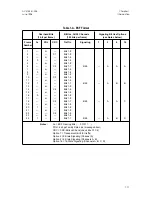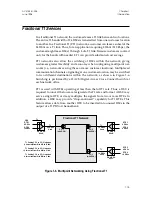
Appendix C. CP01 Chain Port Expander —
This appendix describes the
Larscom CP01 Chain Port Expander, which can link the RS485 facilities
connecting multiple Access-Ts to the supervisory master via RS232 ports.
Appendix D. Access-T Operator Messages —
This appendix lists all
Access-T status and error messages.
Appendix E. Access-T 1500 Accessory Kits
— This appendix describes the
four accessory kits for use with the Access-T 1500 Line/Aux Port connectors.
Appendix F. Standard MIB-II Definitions —
This appendix describes
the implementation of the SNMP MIB-II (RFC 1213).
Appendix G. Access-T DS1 MIB Support —
This appendix lists the DS1
MIB commands supported by Access-T (RFC 1406).
Appendix H. SNMP Trap Support —
This appendix describes the
implementation of the Larscom Private MIB, including trap support.
Appendix I. Point-to-Point Protocol —
This appendix provides sup-
plementary information about PPP as is pertains to Access-T.
T1 Networks
The T1 digital transmission system, carrying DS1 signals, is the primary digital
communication system in North America. A T1 facility provides full-duplex
transmission at 1.544 megabits per second (Mbps). Bandwidth is divided into 8
kbps of overhead and 1.536 Mbps of user information. For digitized voice
applications, the information bandwidth typically consists of 24 multiplexed
64-kbps channels. For the transmission of data, a T1 facility may be channelized
as for voice, or it may carry from one to as many as several hundred multiplexed
signals on an unchannelized basis.
Today’s T1 networks are typically multinodal, with multiple T1 line termina-
tions at each node. Nodes can be located at customer premises or at a carrier’s
Central Office, creating a hybrid public/private networking environment. The
high capacity of T1 facilities allows integration of previously separate voice,
data, facsimile, and image networks into high-speed backbone networks.
Currently, the T1 environment is in the midst of a major change in framing
format. The D4 or Superframe (SF) format is being supplanted by the Extended
Superframe (ESF) format. ESF allows performance monitoring of live traffic
with no decrease in information bandwidth.
ACST-0351-005
Chapter 1
June 1996
Introduction
1-3










































